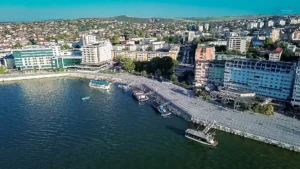
Pygmy Cormorant

Description and how to observe Pygmy Cormorant:
The Pygmy Cormorant is the smallest cormorant species in Europe, measuring about 45-55 cm in length and with a wingspan of up to 90 cm. It is easily recognisable by its small size, short beak, relatively thick neck and black plumage with greenish highlights. When breeding, adults have white patches on the face and white down on the flanks. In the Danube Delta, it can be observed in wet areas with abundant vegetation, reed thickets and shallow lakes, especially in the morning and evening when it is actively fishing or resting on branches and reeds.
What it feeds on Pygmy Cormorant:
The Pygmy Cormorant feeds mainly on small fish and other aquatic organisms such as crustaceans or aquatic insects. It hunts by diving quickly, using its sharp beak and good underwater vision to catch prey. It can often be seen drying its wings in the sun after long periods of diving.
Threats:
The main threats to this species include: habitat destruction through drainage, water pollution, poaching, human disturbance during nesting, and climate change affecting wetlands. It is also sometimes unjustly persecuted because of the perception that it harms fish stocks.
Ecological role:
More information about Phalacrocorax pygmaeus:
The Pygmy Cormorant is a protected species at European level, being included in Annex I of the EU Birds Directive and in the Bern Convention. In Romania, the Danube Delta is one of the most important nesting sites for this species, which makes the protection of this habitat essential for its long-term conservation.
Discover now the most beautiful places in the Danube Delta!
In the following pages, you will find detailed information about:
- Top tourist destinations: Traditional villages, nature reserves, tourist trails and much more.
- Activities and attractions: Everything you need to know about boating, fishing, bird watching, cycling and other activities.
- Accommodation and catering: Accommodation to suit all budgets and restaurants serving traditional cuisine.




